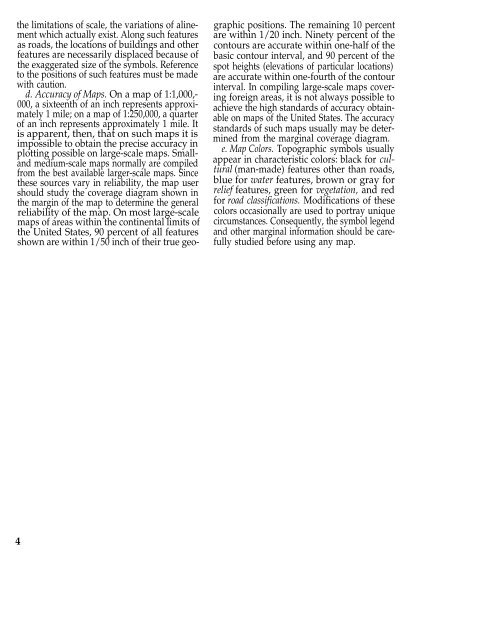US Army - FM 21-31 - Topographic Symbols.pdf
US Army - FM 21-31 - Topographic Symbols.pdf
US Army - FM 21-31 - Topographic Symbols.pdf
You also want an ePaper? Increase the reach of your titles
YUMPU automatically turns print PDFs into web optimized ePapers that Google loves.
the limitations of scale, the variations of alinement<br />
which actually exist. Along such features<br />
as roads, the locations of buildings and other<br />
features are necessarily displaced because of<br />
the exaggerated size of the symbols. Reference<br />
to the positions of such features must be made<br />
with caution.<br />
d. Accuracy of Maps. On a map of 1:1,000,-<br />
000, a sixteenth of an inch represents approximately<br />
1 mile; on a map of 1:250,000, a quarter<br />
of an inch represents approximately 1 mile. It<br />
is apparent, then, that on such maps it is<br />
impossible to obtain the precise accuracy in<br />
plotting possible on large-scale maps. Smalland<br />
medium-scale maps normally are compiled<br />
from the best available larger-scale maps. Since<br />
these sources vary in reliability, the map user<br />
should study the coverage diagram shown in<br />
the margin of the map to determine the general<br />
reliability of the map. On most large-scale<br />
maps of areas within the continental limits of<br />
the United States, 90 percent of all features<br />
shown are within 1/50 inch of their true geo-<br />
4<br />
graphic positions. The remaining 10 percent<br />
are within 1/20 inch. Ninety percent of the<br />
contours are accurate within one-half of the<br />
basic contour interval, and 90 percent of the<br />
spot heights (elevations of particular locations)<br />
are accurate within one-fourth of the contour<br />
interval. In compiling large-scale maps covering<br />
foreign areas, it is not always possible to<br />
achieve the high standards of accuracy obtainable<br />
on maps of the United States. The accuracy<br />
standards of such maps usually may be determined<br />
from the marginal coverage diagram.<br />
e. Map Colors. <strong>Topographic</strong> symbols usually<br />
appear in characteristic colors: black for cultural<br />
(man-made) features other than roads,<br />
blue for water features, brown or gray for<br />
relief features, green for vegetation, and red<br />
for road classifications. Modifications of these<br />
colors occasionally are used to portray unique<br />
circumstances. Consequently, the symbol legend<br />
and other marginal information should be carefully<br />
studied before using any map.

















